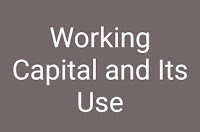Working Capital and Its Use
 |
| Working Capital and Its Use |
The relationship between the source and use of working capital is very close. This means that the use of working capital is chosen from a particular source of working capital or vice versa. The use of working capital will be influenced by the amount of working capital itself. A manager is required to use working capital appropriately, according to the goals the company wants to achieve.
The use of funds for working capital can be obtained from increases in assets and decreases in passivity. Generally it is said that the company can use it for
1. Expenditures on salary, wages and other company operating costs
Expenditures for salary, wages, and other company operating costs mean that the company spends some money to pay salaries, wages and other operating costs used to support sales.
The purpose of spending to buy raw materials or merchandise is on a number of raw materials purchased which will be used for the production process and purchase of merchandise for resale.
2. Spending funds to buy raw materials or merchandise
The purpose of spending to buy raw materials or merchandise is on a number of raw materials purchased which will be used for the production process and purchase of merchandise for resale
3. Cover losses due to the sale of securities
The purpose of spending funds to buy raw materials or merchandise is to cover losses due to the sale of securities or other losses when the company sells securities, but suffers losses. This will reduce working capital and be covered immediately.
4. Fund formation
The formation of funds is the separation of current assets for certain purposes in the long term, for example the formation of pension funds, expansion funds, or debt settlement funds. The formation of these funds will change the shape of assets from current assets to fixed assets.
5. Purchase of fixed assets (land, buildings, vehicles, machinery, etc.)
Purchase of fixed assets means the purchase of fixed assets or long-term investments such as the purchase of land, buildings, vehicles, and machinery. This purchase will result in reduced current assets and the emergence of current debt.
6. Payment of long-term debt (bonds, mortgages, long-term bank debt)
Long-term debt payment means the payment of long-term debt, namely payment of long-term debt that is past due, such as paying off bonds, mortgages, and long-term bank debt.
7. Purchase or withdrawal of outstanding shares
Purchase or withdrawal of outstanding shares means that the company withdraws shares that have been circulated for a particular reason by repurchasing them, either temporarily or forever.
8. Collection of money or goods for personal use
Withdrawal of money or goods for personal purposes means that the owner of the company takes goods or money used for personal gain, including in this case the existence of profit taking or payment of dividends by the company
The use of working capital above will clearly result in changes in working capital, but changes in working capital depend on the use of working capital itself. In practice the working capital of a company will not change if there are purchases of merchandise and other materials in cash, purchases of securities in cash, and changes in forms of accounts receivable such as trade receivables to notes receivable.
It is said that working capital has not changed due to the purchase of goods in cash, its position remains in current assets, only changes in its components. Likewise, the purchase of marketable securities in cash does not change current assets. Meanwhile, changes in the form of receivables, for example from trade receivables to notes receivable, also do not change the position of current debt. Okay, hopefully useful
0 Response to "Working Capital and Its Use"
Post a Comment